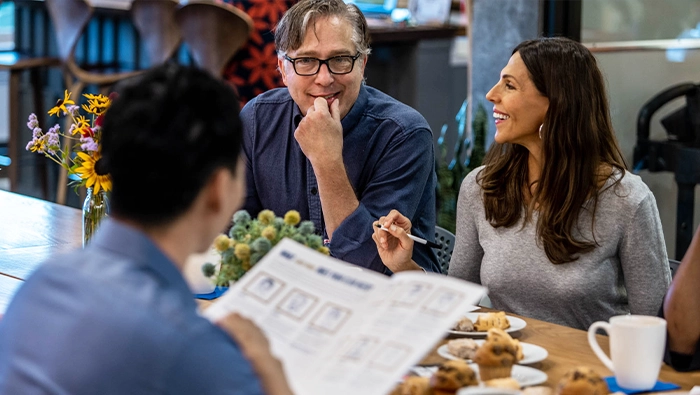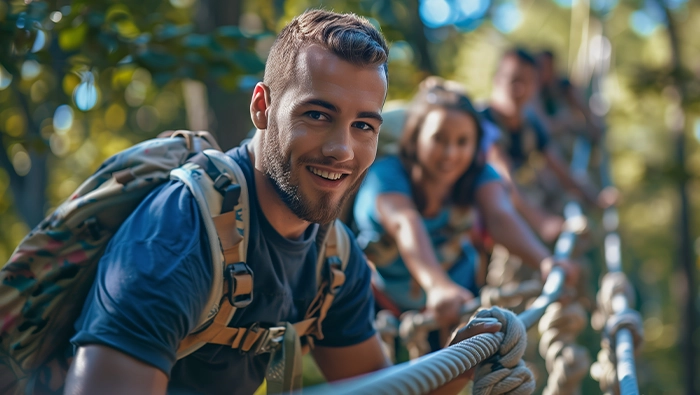When the convention ends, stay a little longer and see where the city leads you.
By Lauren Young
When you come to Manila, Philippines, for the 2026 Kiwanis International Convention, you’ll find even more than the information and inspiration of our big event. You’ll find a city filled with hospitality and history — the kind that invites you to stay a little longer.
If you extend your stay by a day or two before or after the convention, you can immerse yourself in a day full of history, art and leisure — and turn your convention trip into a deeper adventure.
To reach Old Manila from the Manila Marriott Hotel (or any of our preferred hotels), expect a ride of around 30 minutes by rideshare or taxi.
Culture and history
- Intramuros: The Walled City. Intramuros, or “within the walls,” is the historic heart of Manila, founded in 1571 as the seat of colonial government, religion and commerce under Spanish rule. Once inside the walls, you’ll find a compelling mixture of Spanish-colonial architecture, historic fortifications and tranquil courtyards. Highlights include:
- Fort Santiago and Rizal Shrine. One of Manila’s most important historical landmarks, Fort Santiago was built in the late 1500s as a Spanish military fortress and later held prisoners during multiple foreign occupations.
- San Agustín Church and Museum. Completed in 1607, this UNESCO World Heritage site is the oldest stone church in the Philippines. The interior contains a trompe-l’œil painted ceiling, Baroque pipe organ, hand-carved choir seats, religious art and more. The adjoining museum, located in a former monastery, showcases colonial-era paintings, garments and artifacts.
- Casa Manila Museum. Housed in a beautifully restored Spanish colonial-era house in Plaza San Luis, Casa Manila offers a look at upper-class life in the Philippines in the latter half of the 19th century.
- Baluarte de San Diego. At the southern edge of Intramuros, this restored bastion dates to the 1500s and once formed part of Manila’s circular defense wall. Its stone ruins and gardens make a pleasant, scenic place to rest, take photos and imagine the centuries of history the walls have witnessed.
- Binondo (Chinatown). Across the Pasig River from Intramuros lies Binondo, established in 1594. It is considered the world’s oldest continuously inhabited Chinatown. Visitors will find a blend of old and new — historic churches and archways alongside gold shops, noodle houses and herbal stores.
- Binondo Church (Minor Basilica of St. Lorenzo Ruiz). Originally built in 1596, the church stands at the heart of Binondo. Its Baroque façade and octagonal bell tower recall its Spanish and Chinese influences, honoring St. Lorenzo Ruiz, the first Filipino saint.
- Ongpin Street. The main artery of Chinatown, Ongpin is lined with jewelry shops, bakeries and traditional apothecaries. It’s a popular stop for dim sum, hopia (another type of pastry) and other Chinese-Filipino specialties.
- Binondo-Intramuros Bridge. Completed in 2022, this steel arch bridge links the historic walled city with Chinatown. Its pedestrian walkway offers views of the Pasig River and Manila’s old quarter.
Entertainment and leisure
- Manila Ocean Park. Opened in 2008, Manila Ocean Park is one of the city’s most visited attractions. Located directly behind the Quirino Grandstand along Manila Bay, you’ll find over 14,000 marine creatures representing nearly 300 species, many native to Southeast Asia’s tropical waters. The highlight is the Oceanarium, a glass tunnel where guests are surrounded by sharks, stingrays and colorful schools of fish. Beyond the main aquarium, there are themed attractions and live animal shows throughout the day. Manila Ocean Park also is home to several cafés, souvenir shops and shaded viewing decks overlooking the bay.
- Philippine Biodome. Within the same complex as the Ocean Park, the Philippine Biodome is designed to mimic the Philippines’ tropical environments — combining natural exhibits, interactive learning and sustainable design in one lush, green space. As you stroll along its garden walkways, you’ll encounter exhibits on rainwater harvesting, solar energy and native plant species. Explore areas like the Freshwater Gallery, Crocodile Tunnel and Sun Conure Feeding Station — or take the zipline for a bird’s-eye view of the entire dome.
- Divisoria Market. A short ride from Binondo, Divisoria Market is Manila’s traditional wholesale and market district, known for its lively street stalls and bargain shopping. The area developed in the 19th century as a trading hub outside the walled city and remains a favorite spot for locals seeking textiles, clothing and home goods.
Food and dining
- Barbara’s Heritage Restaurant. Located inside the historic Plaza San Luis complex, the restaurant features Filipino-Spanish cuisine. Meals are served in an elegant, wood-paneled dining room, often accompanied by live traditional music and cultural dance performances in the evening.
- Sky Deck at The Bayleaf Hotel. Perched atop The Bayleaf Hotel within Intramuros, the Sky Deck View Bar offers panoramic views of the city skyline and Manila Bay. The menu combines Filipino favorites and international comfort food — from grilled seafood and crispy bagnet (crispy fried pork belly) to pizzas, pasta and salads.
- Ying Ying Tea House. Located on the corner of Yuchengco Street, this three-story restaurant is famous for its wide-ranging Cantonese menu and dim sum specials, including siomai, hakaw and roast meats.
- Wai Ying Fastfood. Popular for its Hong Kong-style dishes served in a simple, canteen-style setting, Wai Ying attracts diners for its Peking duck and reasonable prices. It’s one of Binondo’s most recommended stops.
Manila Bay (30- 40-minute drive)
Just west of the city’s historic core, Manila Bay offers the perfect summer exploration through museums, parks, performing arts venues and more. Start at Rizal Park and slowly make your way down the bay.
Culture and history
- Rizal Park (Luneta Park). Just outside Intramuros lies one of Asia’s largest urban parks — 143 acres of gardens, fountains and monuments along the shores of Manila Bay. The park is named after Dr. José Rizal, whose monument marks the site of his execution and final resting place. Visitors can stroll through themed gardens such as the Chinese and Japanese Gardens, visit the Orchidarium and Butterfly Pavilion or pause by the Central Lagoon and Martyrdom of Dr. Rizal Diorama.
- The National Museum Complex. Bordering Rizal Park is the National Museum Complex, the country’s premier center for art, culture and science. The complex consists of three grand neoclassical buildings:
- National Museum of Fine Arts. Housed in the former Legislative Building, this museum showcases masterpieces of Filipino art across 29 galleries. The highlight is Juan Luna’s painting “Spoliarium” — an 1884 work that symbolizes both artistic triumph and the Filipino struggle for dignity. Visitors also will find sculptures, portraits and modern pieces.
- National Museum of Anthropology. Located in the old Finance Building, this museum focuses on ethnology and archaeology. Exhibits feature precolonial tools, pottery and jewelry, as well as displays on indigenous textiles, maritime heritage and artifacts recovered from shipwrecks like the San Diego galleon.
- National Museum of Natural History. Housed in the former Department of Agriculture and Commerce building, the museum features a central atrium crowned by the steel-and-glass “Tree of Life.” The institution offers numerous galleries dedicated to Philippine biodiversity, with displays of preserved specimens, interactive scientific installations and information on conservation initiatives specific to the Philippines.
Entertainment and leisure
- Robinsons Manila. Located in the Ermita district, Robinsons Manila is one of the city’s largest shopping centers. It includes a mix of international and local retail stores, restaurants, cinemas and services.
- Manila Baywalk. This seaside promenade runs for about 2 kilometers along Roxas Boulevard, toward the Cultural Center of the Philippines. It features palm-lined walkways, benches and open-air cafés, with uninterrupted views of the bay.
- Manila Zoo. Opened in 1959 and renovated in 2022, the zoo is a 5.5-hectare facility housing more than 1,000 animals from 90 species — along with the Botanical Garden, Butterfly Pavilion, Reptile House and a Philippine Endemic Exhibit. Wide, shaded paths make it an accessible and family-friendly attraction.
- Cultural Center of the Philippines (CCP). The country’s main venue for the performing arts houses multiple theaters, galleries and rehearsal halls, as well as major resident companies such as Ballet Philippines and the Philippine Philharmonic Orchestra. The CCP regularly hosts concerts, theater productions, art exhibits and national cultural festivals. The distinctive modernist design by architect Leandro Locsin is a landmark of postwar Philippine architecture.
- Paco Park. Built in 1820 as a cemetery for Spanish friars and Manila’s elite families, the park’s circular design includes the small St. Pancratius Chapel at its center. Now a tranquil space with landscaped gardens and walkways, the park occasionally hosts concerts and cultural events.
Food and dining
- Market Café. This buffet restaurant is known for its open cooking stations and broad selection of international cuisine. Offerings include grilled meats, seafood, Japanese sushi and tempura, Chinese dim sum and Filipino dishes.
- Manila Bay Kitchen. Located at the Admiral Hotel, this restaurant offers Filipino and international fare in a contemporary dining setting with bay views. The menu includes seafood, pasta and local favorites. With indoor and terrace seating available, it serves as a comfortable option for lunch or dinner near the waterfront.
- Harbor View Restaurant. Built on a pier extending into Manila Bay, diners can enjoy the sea breeze while choosing from a menu of seafood and Filipino comfort dishes.
Makati Central Business District (15- to 20-minute drive)
Within the country’s main financial and lifestyle hub, you’ll find lush parks, contemporary museums and a wide range of restaurants.
Culture and history
- Ayala Museum. Located in the heart of Makati’s Greenbelt complex, Ayala Museum’s galleries trace 1,000 years of Filipino craftsmanship and creativity — its permanent exhibits include precolonial gold jewelry, ancient maritime trade artifacts and the Diorama Experience. The museum also hosts lectures and educational programs throughout the year.
- Greenbelt Chapel (Chapel of Sto. Niño de Paz). Set in the middle of the Greenbelt shopping and dining area, the Greenbelt Chapel is a circular, open-air place of worship surrounded by landscaped gardens and ponds. Built in 1983, it serves as a quiet space for reflection within Makati’s commercial district.
- Manila American Cemetery and Memorial. Located in nearby Bonifacio Global City (BCG), the Manila American Cemetery covers 152 acres and contains the graves of over 17,000 U.S. and Filipino soldiers who died during World War II. The site includes a central memorial with mosaic maps and walls engraved with the names of the missing. Maintained by the American Battle Monuments Commission, it is recognized as one of the best-preserved World War II memorials in the Pacific.
Entertainment and leisure
- Bonifacio High Street. In Bonifacio Global City, this outdoor shopping and entertainment area is designed with pedestrians in mind. The complex includes international and local retail stores, restaurants, cinemas and landscaped gardens. Art installations and weekend markets are often held in the area.
- Venice Grand Canal Mall. Located in McKinley Hill, Taguig — and inspired by Venice, Italy — this shopping and dining complex features a man-made canal where visitors can take short gondola rides, as well as European-style architecture, cafés and boutiques.
Food and dining
- Blackbird at the Nielson Tower. Occupying the restored site of Manila’s first airport terminal, Blackbird preserves the building’s Art Deco architecture and serves modern European and Asian-inspired cuisine. Dishes include grilled seafood, steak andpasta.
- The Penthouse 8747. On the rooftop of the Lepanto Building, patrons get views of the Makati skyline. The interior design draws inspiration from 1930s architecture, and the menu focuses on continental dishes, including steak, pasta and light entrees.
- Filling Station Bar and Café. A retro-themed diner decorated with 1950s American memorabilia, the restaurant offers a menu of American comfort food such as burgers, ribs and milkshakes — as well as Filipino classics. The restaurant is open late and is known for its colorful décor and large portions.
- Mercato Centrale. Filipino and international street foods are available at this open-air night market, which operates on select evenings and provides a casual, social dining environment popular with both locals and vendors.
More to explore
Be sure to visit a couple of Manila’s other remarkable sites:
Malacañang Palace (20- to 30-minute drive). Located along the Pasig River in the San Miguel district, this palace has been the official residence of the Philippine president since 1863. Originally built as a private summer house in the mid-1700s, it later became the center of executive governance under Spanish, American and Filipino administrations. Access to the main palace is restricted, but visitors who plan well ahead can arrange tours of the Malacañang Museum and Library, which features state gifts, presidential memorabilia and more.
San Sebastian Basilica (25- to 35-minute drive). Situated in the Quiapo district, San Sebastian Basilica is the only all-steel church in Asia. Completed in 1891, it was prefabricated in Belgium and assembled in Manila, combining Gothic Revival architecture with European stained glass and intricate interiors. A National Historical Landmark, the basilica remains an active parish.
Join us in Manila
Save the dates June 24-27, 2026, on your calendar and begin planning your trip to the 2026 Kiwanis International Convention today. We can’t wait to see you in Manila!



